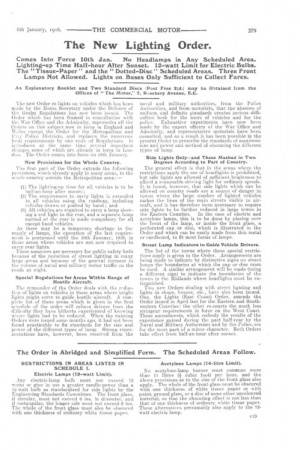The New Lighting Order.
Page 15

If you've noticed an error in this article please click here to report it so we can fix it.
Comes Into Force 10th Jan. No Headlamps in Any Scheduled Area. Lighting-up Time Half-hour After Sunset. 12-watt Limit for Electric Bulbs. The " Tissue-Paper " and the " Dotted-Disc " Scheduled Areas. Three Front Lamps Not Allowed. Lights on Buses Only Sufficient to Collect Fares.
An Explanatory Booklet and Two Standard Discs (Post Free 21d.) may be Obtained from the Offices of "The Motor," 7, flusebery Avenue, E.C.
The new Order re lights on vehicles which has been made by the Home. Secretary. under the Defence of the Realm Regulations has now been issued. The Order which has been framed in consultation with the War Office and the Admiralty, supersedes all the Orders on this subject now in force in England and Wales except the Order for the Metropolitan and City Police Districts, and replaces the numerous local requirements by one code of Regulations, it introduces at the same time several important changes some of which are already in force in London. The Order 'comes into force on 10th January.
New Provisions for the Whole Country.
The first part of the Order extends the following provisions, which already apply in many areas, to the whole country outside the Metropolitan area
(I) The lighting-up time for all vehicles is to be half-an-hour after sunset; (2) The requirement to carry lights is extended to all vehicles using the roadway, including vehicles drawn or pushed by hand ; and
(3). All vehicles are required to carry a lamp showing a red light to the rear, and a separate lamp carried at the rear is made compulsory for all except hand vehicles.
As there may be a temporary shortage in the supply of lamps, the operation of the last requirement is postponed until the 10th January, 1916, in those areas where vehicles are not now required to carry rear lights.
These measures are necessary for public safety both because of the reduction of street lighting in many large .areas and because of the general increase in the volume of naval and military motor traffic on the. reads at night.
Special Regulations for Areas Within Range of . Hostile Aircraft.
The remainder of the Order deals with the reduction of lights on vehicles in those areas where bright lights might serve to guide hostile aircraft. A complete, list of these areas which is given in the first schedule of the order will relieve drivers from the. difficulty they have hitherto experienced of knowing where lights had to he reduced. When the existing Orders were issued some months ago, it had not. been found practicable to fix standards for the .size and power of the different types of lamp. Strong representations have, however, been received from the
naval and military authorities, from the Police Authorities, and from motorists, that the absenceof uniform and definite tan.clards creates serious difficulties both for the users of vehicles and for the police. Exhaustive experithents have now been madeby the expert officers of the War Office and Admiralty, and representative motorists have been consulted, and as a result it has been possible in the present Order to prescribe the standards of maximum size and power and method of obscuring the different types of lamp.
Side Lights Only—and These Masked in Two Degrees According to Part of Country.
The general effect is that in the areas where the restrictions apply the use of headlights is prohibited, but side lights are allowed of sufficient brightness to afford a reasonable driving light for ordinary speeds. It is found, however, that side lights which can. be allowed on country roads are a source of danger in towns where the large number of lighted vehicles makes the lines of the main streets visible to aircraft, and it has therefore been necessary to require side lights to be further reduced in large towns in the Eastern Counties. In the case of electric and acetylene lamps, this is to be done by placing over the front of the lamp, or inside the front glass, a perforated cap or disc, which is illustrated in the Order and which can be easily made from thin metal or cardboard, to fit most forms of lamps.
Street Lamp Indicators to Guide Vehicle Drivers.
The list of the towns where these special restrictions apply is given in the Order. Arrangements are being made to indicate by distinctive signs on street lamps the boundaries at which the cap or disc must be used. A similar arrangement will be made (using a different sign) to indicate the boundaries of the towns in the Midlands where headlights must be extinguished. Two new Orders dealing with street lighting and lights in shops, houses, etc., have also been issued. One, the Lights (East. Coast) Order, amends the Order issued in April last for the Eastern and Southeastern Counties: the other re-enacts the much less stringent requirements in force on the West Coast. These amendments, which embody the results of the experience gained during the past half-year by the Naval anti Military Authorities and by the Police, are for the most part of a minor character. Both Orders take effect from half-an-hour after sunset.




















